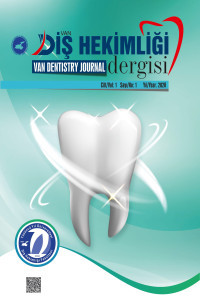Farklı Geçici Kron Materyallerinin Bağlanma Dayanımı Değerlerinin Karşılaştırılması
CAD/CAM, geçici kron materyali, bağlanma dayanımı
Comparison of Different Temporary Crown Materials’ Shear Bond Strength Values
CAD/CAM, shear bond strength, temporary crown material,
___
- 1. Gökalp S, Doğan GB, Tekçı̇ çek M, Berberoğlu A, Ünlüer Ş. Erişkin ve yaşlılarda ağız-diş sağlığı profili Türkiye-2004. Hacettepe Dişhekimliği Fakültesi Derg. 2007;31(4):11-8.
- 2. Chow L, Goonewardene MS, Cook R, Firth MJ. Adult orthodontic retreatment: A survey of patient profiles and original treatment failings. Am J Orthod Dentofac Orthop. 2020;158(3):371-82.
- 3. Burns DR, Beck DA Nelson SK, Committee on Research in Fixed Prosthodontics of the Academy of Fixed Prosthodontics. A review of selected dental literature on contemporary provisional fixed prosthodontic treatment: report of the Committee on Research in Fixed Prosthodontics of the Academy of Fixed Prosthodontics. J Prosthet Dent. 2003;90(5):474-97.
- 4. Heithersay GS. Combined endodonticorthodontic treatment of transverse root fractures in the region of the alveolar crest. Oral Surg Oral Med Oral Pathol. 1973;36(3):404-15.
- 5. Al Jabbari YS, Al Taweel SM, Al Rifaiy M, Alqahtani MQ, Koutsoukis T, Zinelis S. Effects of surface treatment and artificial aging on the shear bond strength of orthodontic brackets bonded to four different provisional restorations. Angle Orthod. 2014;84(4):649-55.
- 6. Richardson G, Russell KA. Congenitally missing maxillary lateral incisors and orthodontic treatment considerations for the single-tooth implant. J Can Dent Assoc. 2001;67(1):25-8.
- 7. Blakey R, Mah J. Effects of surface conditioning on the shear bond strength of orthodontic brackets bonded to temporary polycarbonate crowns. Am J Orthod Dentofac Orthop. 2010;138(1):72-8.
- 8. Balkenhol M, Knapp M, Ferger P, Heun U, Wöstmann B. Correlation between polymerization shrinkage and marginal fit of temporary crowns. Dent Mater. 2008;24(11):1575-84.
- 9. Zarif Najafi H, Moradi M, Torkan S. Effect of different surface treatment methods on the shear bond strength of orthodontic brackets to temporary crowns. Int Orthod. 2019;17(1):89- 95.
- 10. Shillingburg HT, Hobo S, Whitsett LD, Brackett SE. Fundamentals of Fixed Prosthodontics. 1997.
- 11. Abdullah AO, Tsıtrou EA, Pollıngton S. Comparative in vitro evaluation of CAD/CAM vs conventional provisional crowns. J Appl Oral Sci. 2016;24(3):258-63.
- 12. Chay SH, Wong SL, Mohamed N, Chia A, Yap AUJ. Effects of surface treatment and aging on the bond strength of orthodontic brackets to provisional materials. Am J Orthod Dentofac Orthop. 2007;132(5): 577.e7-11.
- 13. Proffit WR, Fields HW, Larson B, Sarver DM. Contemporary orthodontics. Elsevier Health Sciences; 2018.
- 14. Reynolds IR. A Review of Direct Orthodontic Bonding. Br J Orthod. 1975;2(3):171-8.
- 15. Rambhia S, Heshmati R, Dhuru V, Iacopino A. Shear bond strength of orthodontic brackets bonded to provisional crown materials utilizing two different adhesives. Angle Orthod. 2009;79(4):784-9.
- 16. Kirmali O, Akin H, Ozdemir AK. Shear bond strength of veneering ceramic to zirconia core after different surface treatments. Photomed Laser Surg. 2013;31(6):261-8.
- 17. Garcés GA, Rojas VH, Bravo C, Sampaio CS. Shear bond strength evaluation of metallic brackets bonded to a CAD/CAM PMMA material compared to traditional prosthetic temporary materials: an in vitro study. Dent Press J Orthod. 2020;25(3):31-8.
- 18. Goymen M, Topcuoglu T, Topcuoglu S, Akin H. Effect of different temporary crown materials and surface roughening methods on the shear bond strengths of orthodontic brackets. Photomed Laser Surg. 2015;33(2):55-60.
- 19. Powers JM, Kim HB, Turner DS. Orthodontic adhesives and bond strength testing. Semin Orthod. 1997;3(3):147-56.
- 20. Christensen GJ. The fastest and best provisional restorations. J Am Dent Assoc 1939. 2003;134(5):637-9.
- 21. Khan Z, Razavi R, von Fraunhofer JA. The physical properties of a visible light-cured temporary fixed partial denture material. J Prosthet Dent. 1988;60(5):543-5.
- 22. Yao J, Li J, Wang Y, Huang H. Comparison of the flexural strength and marginal accuracy of traditional and CAD/CAM interim materials before and after thermal cycling. J Prosthet Dent. 2014;112(3):649-57.
- 23. Wiegand A, Stucki L, Hoffmann R, Attin T, Stawarczyk B. Repairability of CAD/CAM high-density PMMA- and composite-based polymers. Clin Oral Investig. 2015;19(8):2007- 13.
- 24. Alt V, Hannig M, Wöstmann B, Balkenhol M. Fracture strength of temporary fixed partial dentures: CAD/CAM versus directly fabricated restorations. Dent Mater. 2011;27(4):339-47.
- 25. Güth JF, Almeida E Silva JS, Ramberger M, Beuer F, Edelhoff D. Treatment concept with CAD/CAM-fabricated high-density polymer temporary restorations. J Esthet Restor Dent. 2012;24(5):310-8.
- 26. Stawarczyk B, Özcan M, Trottmann A, Schmutz F, Roos M, Hämmerle C. Two-body wear rate of CAD/CAM resin blocks and their enamel antagonists. J Prosthet Dent. 2013;109(5):325-32.
- 27. Hensel F, Koenig A, Doerfler HM, Fuchs F, Rosentritt M, Hahnel S. CAD/CAM ResinBased Composites for Use in Long-Term Temporary Fixed Dental Prostheses. Polymers. 2021;13(20):3469.
- 28. Cumerlato M, de Lima EM, Osorio LB, Mota EG de Menezes LM, Rizzatto SMD. Effect of surface treatment of prefabricated teeth on shear bond strength of orthodontic brackets. Dent Press J Orthod. 2017;22(4):47- 52.
- 29. Dias FMCS, Pinzan-Vercelino CRM, Tavares RR de J, Gurgel J de A, Bramante FS, Fialho MNP. Evaluation of an alternative technique to optimize direct bonding of orthodontic brackets to temporary crowns. Dent Press J Orthod. 2015;20(4):57-62.
- 30. Lundvall PK, Ruyter E, Rønold HJ, Ekstrand K. Comparison of Different Etching Agents and Repair Materials Used on Feldspathic Porcelain. J Adhes Sci Technol. 2009;23(7-8):1177-86.
- Başlangıç: 2020
- Yayıncı: Van Yüzüncü Yıl Üniversitesi
Sınıf II Maloklüzyonun Carriere Motion Apareyi ile Tedavisi
Talon Tüberküllerin Radyolojik ve Klinik Açıdan Değerlendirilmesi
Sema KAYA, Mustafa BİLEN, Alaettin KOÇ
Klinik Olarak Stabil Dental İmplant Çevresi Mikrobiyal Flora
Pleomorphic Adenoma of the Palate: A Case series
Mohammad ALNASRALLAH, Yusuf Rodi MIZRAK, Abdalrahim HUSSEIN, Basem ALSHUJAA, Serap KESKİN TUNÇ
Dicle ALTINDAL, Hacer ŞAHİN AYDINYURT, Kübra ESKİN, Mohammad ALKHATİB, Duygu KORKMAZ YALÇIN
Mine Hipoplazili Anterior Dişlerin Direkt Kompozit Rezin ile Estetik Rehabilitasyonu: 2 Yıllık Takip
İkbal Esra PEHLİVAN, Alperen DEĞİRMENCİ
Farklı Geçici Kron Materyallerinin Bağlanma Dayanımı Değerlerinin Karşılaştırılması
Yasemin TUNCA, Seda KOTAN, Nihal FAHRZADEH, Murat TUNCA, Beyza ÜNALAN DEĞİRMENCİ, Duygu KORKMAZ YALÇIN
Aşırı Dişeti Görünümünün Tedavisinde Dudak Repozisyonu Uygulaması: Olgu Serisi
